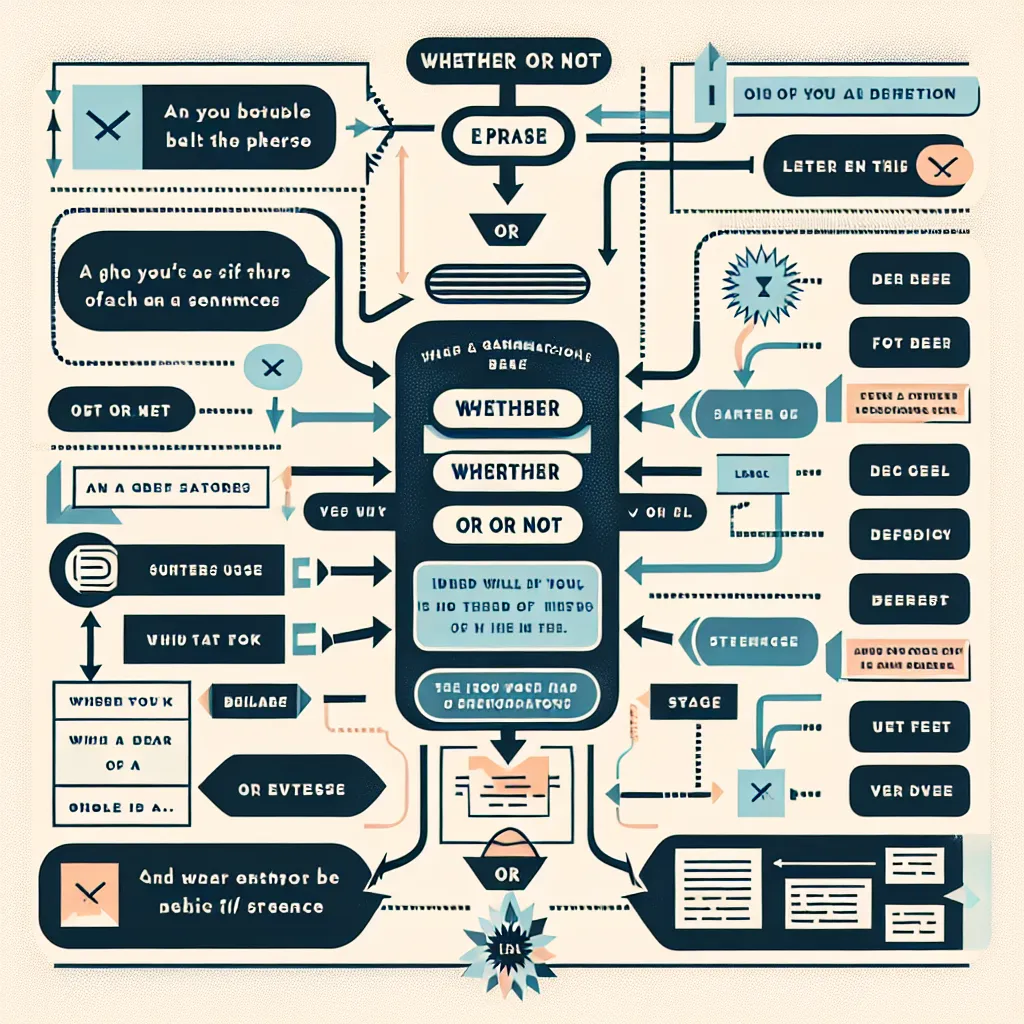“Whether or not” is a crucial phrase in English grammar that often appears in IELTS exams. Understanding its usage can significantly enhance your performance across all sections of the test. This guide will explore the intricacies of “whether or not,” providing you with the knowledge and skills to use it effectively in your IELTS journey.
Understanding “Whether or Not”
“Whether or not” is used to introduce two alternatives in a sentence, indicating that the outcome or action will occur regardless of which alternative is true. It’s commonly used in both formal and informal contexts, making it valuable for various IELTS tasks.
 Whether or Not Usage Diagram
Whether or Not Usage Diagram
Basic Structure
The basic structure of sentences using “whether or not” is:
(Subject) + (Verb) + whether or not + (Clause)
Examples:
- I will go to the party whether or not it rains. (Main clause + whether or not + clause)
- She hasn’t decided whether or not to accept the job offer. (Main clause + whether or not + infinitive phrase)
- The project will continue whether or not we receive additional funding. (Main clause + whether or not + clause)
Usage in IELTS Writing
In IELTS Writing, using “whether or not” can demonstrate your ability to discuss alternatives and show sophisticated grammar usage. Here are some examples:
-
Task 2 Essay: “Governments should invest in renewable energy sources whether or not they are currently cost-effective.” (This sentence shows your ability to discuss policy decisions while considering multiple factors.)
-
Task 1 Report: “The graph illustrates the company’s profits whether or not new products were introduced that year.” (This usage helps in comparing data across different scenarios.)
Incorporation in IELTS Speaking
For the Speaking test, using “whether or not” can showcase your fluency and range of expression:
-
Part 2 (Cue Card): “I had to decide whether or not to pursue higher education abroad.” (This demonstrates your ability to discuss personal decisions.)
-
Part 3 (Discussion): “The success of a business often depends on whether or not it can adapt to changing market conditions.” (This shows your capacity to discuss complex ideas.)
Advanced Usage and Variations
Omitting “Or Not”
In some cases, “or not” can be omitted without changing the meaning:
- “I’m unsure whether I should attend the conference.” (Equivalent to “whether or not”)
Using “Regardless of Whether”
This phrase is interchangeable with “whether or not” and can be used for variety:
- “The event will take place regardless of whether it rains.” (Equivalent to “whether or not it rains”)
“Whether… or” Structure
This structure is used to present clear alternatives:
- “We need to decide whether to invest in stocks or bonds.” (Presenting two specific options)
Common Mistakes and How to Avoid Them
-
Confusion with “Weather”:
Incorrect: “I don’t know weather or not I’ll pass the exam.”
Correct: “I don’t know whether or not I’ll pass the exam.” -
Using “If” Instead:
While “if” can sometimes be used interchangeably, it’s not always correct:
Incorrect: “She’s unsure if or not she’ll attend.”
Correct: “She’s unsure whether or not she’ll attend.” -
Incorrect Word Order:
Incorrect: “Whether not or he comes doesn’t matter.”
Correct: “Whether or not he comes doesn’t matter.”
Enhancing Your IELTS Score with “Whether or Not”
Using “whether or not” correctly can contribute to higher band scores in IELTS:
-
Band 6: Basic use in simple contexts
Example: “I’m not sure whether or not I’ll go to the party.” -
Band 7-8: More sophisticated use in complex sentences
Example: “The efficacy of the new policy remains to be seen, regardless of whether or not it gains public support initially.” -
Band 9: Advanced use in nuanced discussions
Example: “The long-term economic implications of the decision will be significant, whether or not immediate financial gains are realized, thus necessitating a thorough analysis of potential outcomes.”
Conclusion
Mastering the use of “whether or not” is crucial for IELTS success. It allows you to express uncertainty, discuss alternatives, and demonstrate advanced grammar skills. Practice incorporating this phrase into your writing and speaking to enhance your overall language proficiency. Remember to use it naturally and appropriately in context, and you’ll be well on your way to achieving your desired IELTS score.
To further improve your skills, try creating sentences using “whether or not” in various contexts related to common IELTS topics such as education, technology, environment, and social issues. This practice will help you become more comfortable with the phrase and ready to use it effectively in your IELTS exam.


